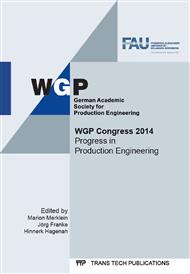[1]
W. Tilch; H. Polzin, GIFA 2003: Formstoffe, Formverfahren und Maschinen zur Form- und Kernherstellung, Formstoffaufbereitung und Regenerierung. Giesserei-Praxis (2003) 407-429.
Google Scholar
[2]
H. Polzin, Übersicht chemisch härtende Formstoffe, Giesserei-Praxis (2007) 334-357.
Google Scholar
[3]
P. Groening, Formverfahren mit nicht tongebundenen Formstoffen, Giesserei 99 (2012) 34-43.
Google Scholar
[4]
T. Pabel, Anorganisches Bindersystem: Einsatz von INOTEC-Kernen für deutlich verbesserte mechanische Eigenschaften von Al-Gussteilen, Giesserei-Praxis (2009) 359-366.
Google Scholar
[5]
H. Polzin, Anorganische Binder zur Form- und Kernherstellung in der Gießerei. first ed., Schiele & Schön, Berlin, (2012).
Google Scholar
[6]
I. Ederer, Werkzeuglose Formherstellung mittels 3D-Drucktechnologie, Giesserei-Praxis (2004) 407-410.
Google Scholar
[7]
A. Psimenos, The new EU-Regulation on Classification, Labelling and Packaging of Substances and Mixtures on the Foundry Industry, Giesserei-Rundschau 58 (2011) 10-13.
Google Scholar
[8]
E. Weissenbek, J. Willimayer, J. Wolf, BMW-Leichtmetallgießerei setzt auf anorganische gebundene Kerne, Giesserei 95 (2008) 32-35.
Google Scholar
[9]
VDI-Richtlinie 3404, Generative Fertigungsverfahren Rapid-Technologien (Rapid Prototyping) Grundlagen, Begriffe, Qualitätskenngrößen, Liefervereinbarungen, Beuth, Berlin, (2009).
Google Scholar
[10]
R. Höchsmann, Wie das 3-D-Druckverfahren Gießereiprozesse revolutioniert. Giesserei 100 (2013) 66-68.
Google Scholar
[11]
J.M. Ségaud, Vision 2025 - 3D - Drucken von Kernen, Giesserei 101 (2014) 24-25.
Google Scholar
[12]
U. Berger, A. Hartmann, D. Schmid, Additive Fertigungsverfahren: Rapid Prototyping, Rapid Tooling, Rapid Manufacturing, first ed., Europa Lehrmittel, Haan-Gruiten, (2013).
DOI: 10.3139/9783446436527.005
Google Scholar
[13]
C. Wallenhorst, Grundlagen zum Verständnis der anorganischen Kernfertigung, Giesserei-Praxis (2010) 181-184.
Google Scholar
[14]
B. Utela, D. Storti, R. Anderson, M. Ganter, A review of process development steps for new material systems in three dimensional printing (3DP), Journal of Manufacturing Processes 10 (2008) 96-104.
DOI: 10.1016/j.jmapro.2009.03.002
Google Scholar
[15]
VDG-Merkblatt: Prüfung von tongebundenen Formstoffen P38: Bestimmung der Festigkeit, VDG Akademie, Düsseldorf, (1997).
Google Scholar
[16]
VDG-Merkblatt: Bindemittelprüfung P72: Prüfung von kalthärtenden, kunstharzgebundenen feuchten Formstoffen mit Härterzusatz, VDG Akademie, Düsseldorf (1999).
Google Scholar
[17]
R. Danzer, T. Lube, P. Supancic; M. Damani, A. Boerger; R. Binder, Verfahren und Einrichtung zur Bestimmung der Bruchfestigkeit von spröden Werkstoffen, Patent No. AT 411 714 B, (2002).
Google Scholar
[18]
R. Danzer, P. Supancic; W. Harrer, Der 4-Kugelversuch zur Ermittlung der biaxialen Biegefestigkeit spröder Werkstoffe, in: Kriegesmann, Technische Keramische Werkstoffe, HvB Verlag, Ellerau, 2009, pp.1-48.
Google Scholar
[19]
H. Gercek, Poisson's ratio values for rocks, International Journal of Rock Mechanics & Mining Sciences 44 (2007) 1-13.
DOI: 10.1016/j.ijrmms.2006.04.011
Google Scholar


